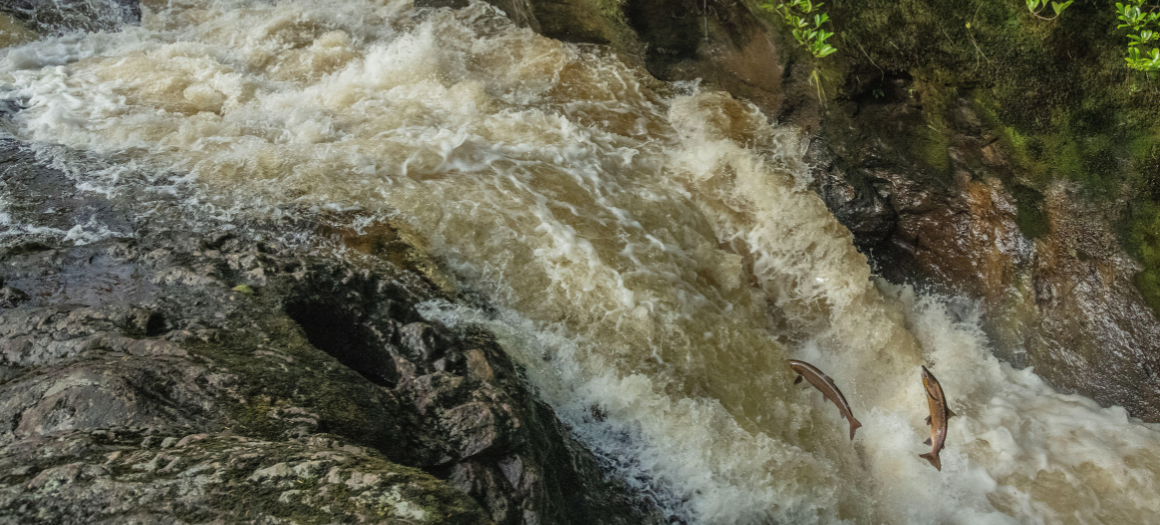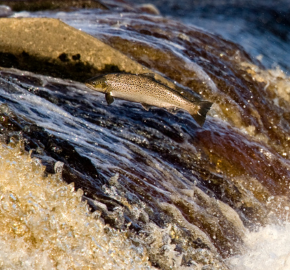Life Beneath the Surface of UK Rivers: How Fish Adapt to Autumn

As the leaves begin to turn, the life within Britain’s rivers undergoes its own transformation. Beneath the surface, fish sense the shift towards shorter days, cooler currents, and subtle changes in flow and light.
Autumn in the UK’s freshwater ecosystems is a time of preparation, movement, and adaptation. For fish, whose physiology is governed by water temperature, this season signals a slowdown in metabolism – yet also a window of intense activity. Many species must feed, migrate, and/ or spawn before the harsher months close in.
In this blog, we explore how fish adjust their behaviour alongside the changing seasons.
Migratory Salmonids: The Urge to Spawn
Few scenes capture the power of seasonal change like the autumn run of salmon and trout. Atlantic salmon (Salmo salar) and brown trout (Salmo trutta) begin their upstream migrations as river levels rise with the first heavy rains. Their goal is to reach clean, well-oxygenated gravel beds where they can dig redds (nests) and lay eggs before winter sets in.
Autumn’s higher flows can both help and hinder this epic journey. Increased discharge opens migration routes that may have been impassable in summer’s low water, but it also brings turbulence and sediment. Fine sediments washed in by autumn floods can infiltrate spawning gravels, clogging the spaces between stones where eggs develop. This reduces oxygen supply, suffocating embryos or washing eggs away entirely. For salmonids, timing is everything: spawn too early, and warm temperatures may threaten egg survival; too late, and floods may scour the redds before hatching.

Image 01: wild salmon leap the Buchanty Spout on the River Almond in Scotland as they bravely seek to complete their epic migration. ©Alamy
Coarse Fish: Seeking Shelter and Stability
While salmon and trout push upstream, coarse fish such as roach (Rutilus rutilus), chub (Squalius cephalus), barbel (Barbus barbus), and bream (Abramis brama) begin to adjust their own positions within the river. Many of these species will move downstream into deeper, slower channels and areas of slack water as flows rise. These areas allow fish to conserve energy and provide refuge from turbulent currents and sharp changes in water temperatures. Species like barbel may also become increasingly active roaming more freely and feeding heavily to improve their condition for the winter months ahead.
Autumn also marks the start of more cohesive shoaling (a social behaviour where a group of fish stay together). Roach, dace, and chub, which may have spent summer dispersed, now gather into larger groups. Shoaling improves hydrodynamic efficiency, reduces individual energy expenditure, and provides safety in numbers against predators. This behaviour becomes even more pronounced as light levels drop and visual cues for predators diminish.

Image 02: a shoal of roach and dace who, having spent the summer dispersed, will now gather in larger groups. ©Jack Perks // Alamy
Predators: The Autumn Feed
For predatory species, autumn represents opportunity. Pike (Esox lucius),and perch (Perca fluviatilis), as well as the invasive zander (Sander lucioperca) ramp up feeding activity in what anglers often call the “autumn feed.” Prey fish are still active, water clarity improves, and cooler temperatures mean that oxygen levels are high, – creating perfect hunting conditions.
This feeding frenzy isn’t just opportunistic; it’s a finely tuned survival strategy. As winter approaches and prey activity drops, predators face a metabolic trade-off: hunting becomes energetically expensive, but their caloric needs remain. By gorging in autumn and early winter, they build essential fat reserves to see them through the leaner months ahead.
Pressures on Autumn Rivers
Autumn has always been a time of change, but increasing pressure from human activities is amplifying the challenges fish face during this transitional season.
1. Flooding and sediment
Intense rainfall events, increasingly frequent with climate change, mobilise fine sediment from agricultural land and urban surfaces. This sediment infiltrates spawning gravels and smothers developing eggs, threatening entire salmonid generations.
2. Flow regulation
Dams and weirs disrupt the natural timing and variability of autumn flows. What once were vital migration cues are now dampened or delayed, preventing salmon and trout from reaching their spawning grounds at optimal times.
3. Pollution and runoff
Autumn rains wash nutrients, pesticides, and road salt into rivers. This not only degrades water quality but also impacts invertebrate communities, undermining the food web just as fish are preparing for winter scarcity.
4. Temperature shifts:
Warmer autumns can delay migration and spawning, while erratic cold snaps can shock juvenile fish. Disrupted seasonal temperature cues can reduce juvenile salmon recruitment.

Image 03: Autumn brings with it increased rainfall, flooding and temperature sifts disrupting seasonal fish behaviour and increasing pollution risk.
For fish, autumn is more than a seasonal bridge between warmth and cold – it sets the stage for spawning success and overwinter survival. Understanding their behavioural changes is increasingly important as pressures on their survival escalate.




